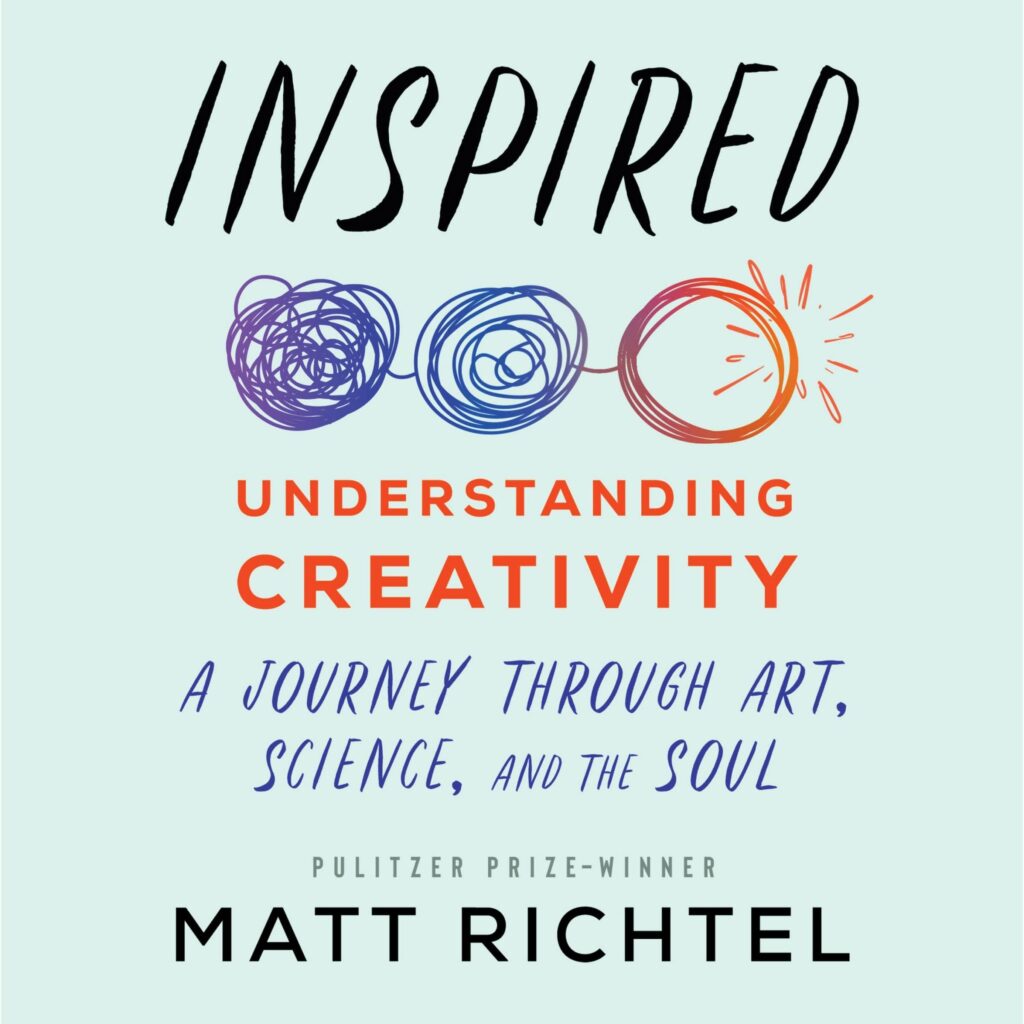You learn stuff while reading Matt Richtel’s new book, Inspired: Understanding Creativity: A Journey Through Art, Science, and the Soul (Mariner). Even if you’re a creative roots-chaser like me and have read extensively about the topic in nonfiction books, psychology texts, neuroscience meta-analysis studies, white papers, and clinical studies, or in the dozens of articles that proliferate in online journals and print publications. All of that reading, especially when added to interviews with creativity wonks I’ve conducted as a journalist, has taught me one primary lesson: how very, very much I still don’t know.
Gleaning knowledge from the Bay Area-based Pulitzer Prize–winning journalist’s book was also not unexpected after having the same experience with An Elegant Defense, Richtel’s prior, fascinating book about the human immune system. Similarly, Inspired is robustly researched. The New York Times science reporter speaks to or considers creativity in the work of adjudicators, scholars, musicians, scientists, entrepreneurs, business and spiritual leaders… looping in former US Chief Justice John Marshall, NBA Golden State Warriors coach Steve Kerr, singer Rhiannon Giddens, cellist Yo-Yo Ma, and, breaching earthly limitations, even Jesus.

Given each new topic (let’s call creative newness “B”) and multiple stories from Richtel’s own experience told in his I’m-just-a-familiar-kinda-guy tone (call that familiarity “A”), Inspired rips wide-ranging examples from real life to show how famous and not-at-all famous people embody the concepts presented. Richtel’s mathematical equation of creativity combines the familiar (A) plus the new (B), and results in “Big Cs,” those radical, transformative ideas, movements, products, processes, and discoveries that change whole fields—and our lives. It’s an equation that could also describe Richtel’s writing style, but in the book, he earmarks it as fundamental to creativity.
Another central point? We are all innately creative, to some extent. (Watch a toddler turn a Lego box—not the Legos, the box—into a hat, a hideaway home for stuffed animals, or, by dumping the contents with raucous sound, an avant garde percussion instrument.)
Of course, it’s not that simple nor is it even desirable to constrain creativity into such simple, linear recipes. Some folks doing prominent or obscure work perform miracles of creative innovation and produce life-changing inventions. Others don’t. What thrusts a person into an orbit of complex colors and trajectories that results in innovation is multifaceted.
Creative people, we learn, expose themselves to more material and are slower to dismiss non-conforming information. They are sometimes motivated by inner misery. That internalized unhappiness might be masked by external success other people see—but it’s success they experience as false, empty, depressing. Propelled by pain, such people react creatively by blurting out crazy thoughts, telling tall tales, pursuing countercultural ideas, believing in fantastical pursuits in which they find meaningful purpose. Richtel writes that the core elements of creative inspiration happen “when you don’t know what you’re going to say next but you trust yourself to say it anyway.”

All this personal fearlessness, irrational faith, and ability to exist on the edge of chaos or psychosis would often be and has been at times entirely wasted without a few crucial external factors. Creators operate best in the right environments (supportive, but not a hothouse of “yes”), and when there is a confluence with obvious or seedling movements in art, politics, business or technology. There is also dumb luck, such as timing that has different ideas converging and colliding without destroying each other, or new technology like the mind-boggling global connectivity of the internet that broadens the playing field. Meaningfulness rewards a creative mind as it slogs to a solution—or to the next best question.
Among the information that struck me as “novel” or less developed by other writers was found in a chapter on the brain that unpacked scholar Joy Paul Guilford’s four qualities associated with creativity. Fluency, originality and flexibility came as no surprise, but detail, the final category, caught my attention. The ability to analyze and trim the fluff from an idea—after allowing the imagination to romp about unleashed—was a reminder that there’s hard work and honing involved in Big Cs.
Creative expression as a relief for shame was another unexpected reframing. Richtel and experts he speaks with say people find psychological and even physical relief by directing secrets that generate feelings of shame into creative applications and outlets—without literally telling their secret stories. Call it abstract behavioral therapy, call it whatever you like, but it’s a forceful energy behind more than one smart idea.
Less interesting were chapters on facts today well known: High IQ isn’t always or even often a factor; creativity exists in nature/biology such as what is found in bacteria; and peer pressure, bad parenting, and perfectionism are enemies of creativity.
As I finished reading Inspired, thinking about the common features of the creatives profiled, I was struck by one truth Richtel never spotlighted but managed to emphasize nonetheless. Creatives are rarely, if ever, thinking about their own creativity or its composition. Even the people who study creativity aren’t thinking about it; they’re trying to find a missing puzzle piece in understanding the brain or searching for clues as to why the kid they knew in childhood or maybe their sister seems to tick to a different clock. Possibly, creatives are all like Richtel: people with curiosity who sift for stones in a sand boxes and, finding one, toss it through a nearby window to discover what happens. Breaking the glass, they might marvel at the sound waves or wonder why the shards fall to the ground in a certain pattern.
Allowed freedom, Inspired reminds us that a curious mind is an unstoppable force and cause for celebration.





